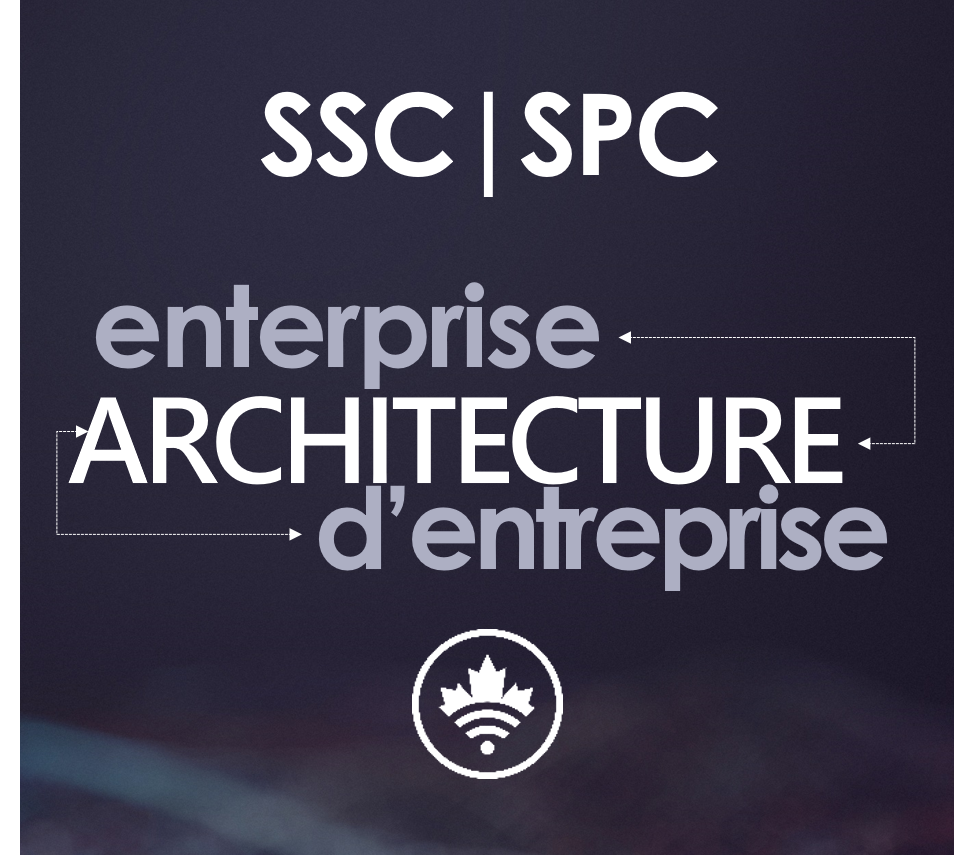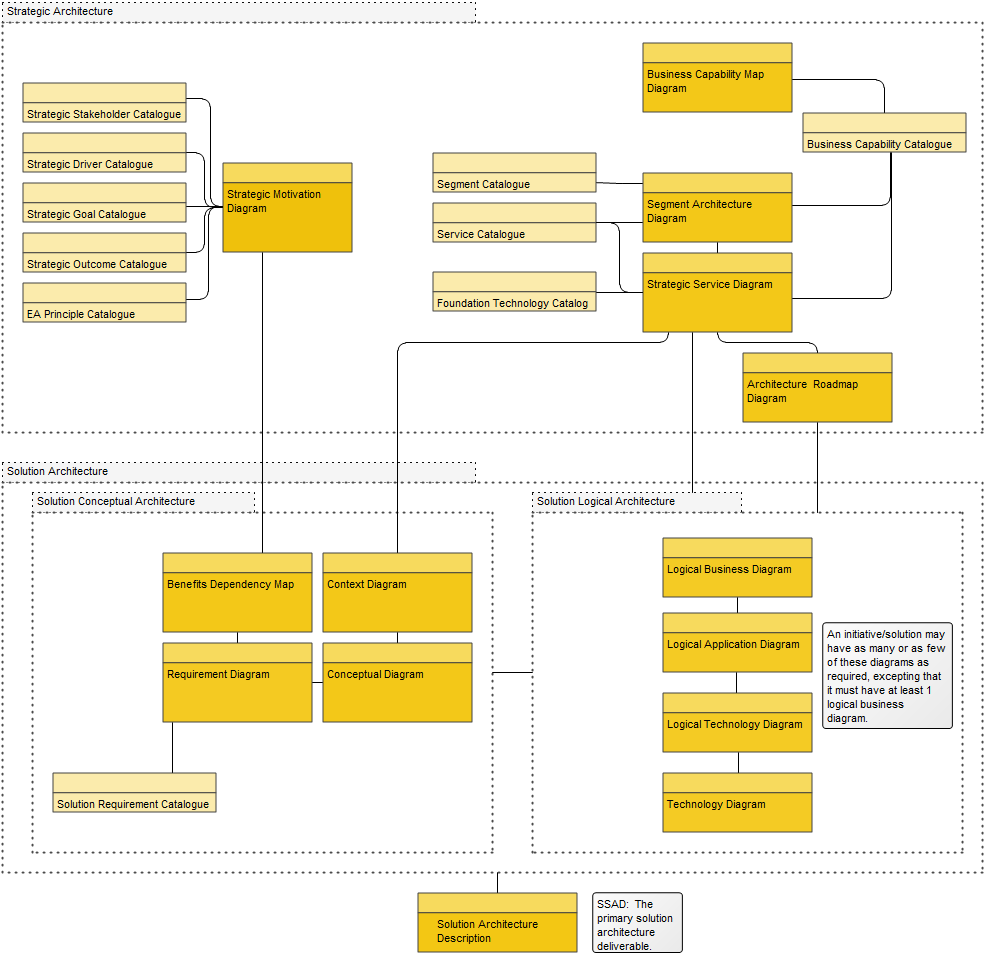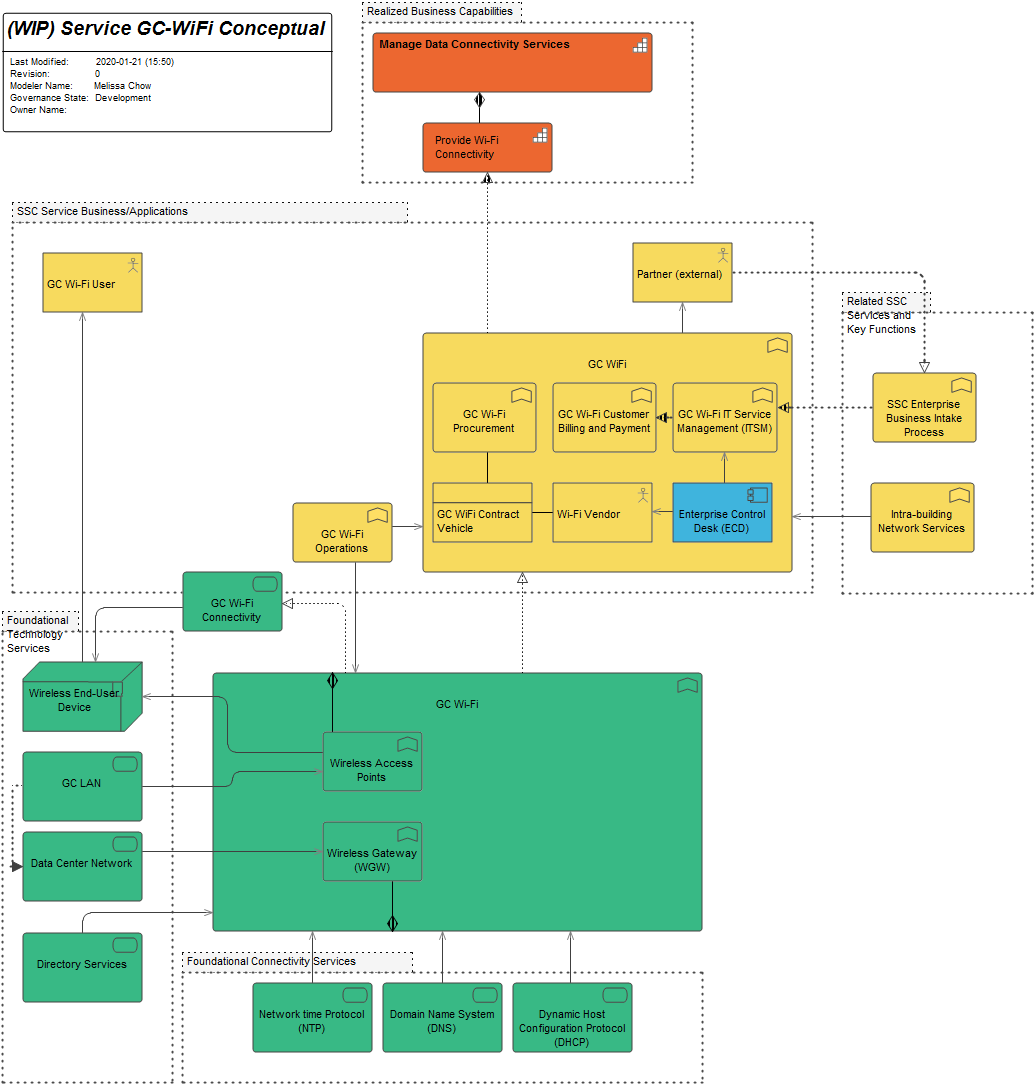Difference between revisions of "SSC Artifacts and Diagrams"
(Updated Conceptual Service Diagram name to be Strategic Service Diagram. Updated some descriptive text. Removed Foundation technology diagram as a separate template - as it's now combined in the Strategic Service Diagram.) |
m |
||
| Line 5: | Line 5: | ||
[[File:EA_Models_Structure.png|frameless|944x944px]] | [[File:EA_Models_Structure.png|frameless|944x944px]] | ||
| − | === | + | === Strategic Architecture === |
==== Strategic Motivation Analysis ==== | ==== Strategic Motivation Analysis ==== | ||
Revision as of 20:25, 22 September 2020
In addition to a content metamodel, SSC has established a set of specific artifacts (catalogs, matrices, diagrams) that are required. In general, these artifacts follow the recommended viewpoints established in the ArchiMate 3.0.1 Specification. However, in some instances we have chosen diagrams that better suit our particular needs, particularly in respect to project and service governance. The following are the required and recommended artifacts for architecture at SSC.
SSC Key EA Artifacts Diagram
Strategic Architecture
Strategic Motivation Analysis
This set of catalogs and diagrams are used to, at the enterprise/strategic level, identify the motivators for SSC. These include strategic plans and directions, legislation, policy, GC Initiatives, and more. The items managed here are intended to be leveraged organization-wide.
Motivation Diagram
ArchiMate Viewpoint: Motivation Viewpoint
Scope/Constraints: None.
Key Stakeholders: Enterprise architects, business analysts, strategic planning, benefits realization team.
Purpose/Value: Used to identify and related the key strategic drivers, goals, outcomes of the organization, and the key strategic stakeholders. Provides links to identify what existing and planned architecture are supporting the enterprise's desired target direction.
Business Capability Map
ArchiMate Viewpoint: Capability Map
Scope/Constraints: Generally limited to identifying capabilities/sub-capabilities, and their association with enterprise strategic outcomes, goals, drivers.
Key Stakeholders: Senior executives, branches, business managers, enterprise and business architects. Investment prioritization.
Purpose/Value: A primary communication mechanism with SSC executives on the state of the architecture, activities, and progress towards desired target direction. Helps ensure alignment between current/target activities and the strategic direction/capabilities of the organization. Investment prioritization.
Strategic Architecture
Segment/Service Overview Diagram
ArchiMate Viewpoint: Business Process Cooperation Viewpoint
Scope/Constraints: Uses only business functions, and business functions with categories "SSC Segment", "SSC Client-facing Service", and "SSC Supporting Service". It does not show detailed information about roles, processes, information, technologies, applications involved in each segment. One diagram shows all segments, and key high-level associated functions.
Key Stakeholders: Enterprise architects/Enterprise Architecture management/executives.
Purpose/Value: Enables EA to organize, prioritize and assign architecture work/activities. In particular, it identifies the segments that will be used to organize EA work, and distributes the key services/functions among them. Segment diagrams are produced for each segment that provides a more complete definition of what belongs in each segment.
Segment Diagram
ArchiMate Viewpoint: Business Process Cooperation Viewpoint
Scope/Constraints: Uses only business functions, and business functions with categories "SSC Segment", "SSC Client-facing Service", and "SSC Supporting Service". It may begin to associate key high-level roles, information, applications - but generally, it leaves details of architecture to dedicated lower-level diagrams. One diagram per defined segment.
Key Stakeholders: Enterprise architects/Enterprise Architecture management/executives.
Purpose/Value: Enables EA to organize, prioritize and assign architecture work/activities. In particular, it identifies the segments that will be used to organize EA work, and distributes the key services/functions among them.
Strategic Service Diagram (formerly Conceptual Service Diagram)
ArchiMate Viewpoint: Layered Viewpoint
Scope/Constraints: A template is provided to complete the diagram. This particular diagram links the SSC Service to Business Capabilities (1 or more), and to other key business functions/services, and to the key foundational/supporting technologies. Similar to the Conceptual Foundation Technology diagrams, except the focus here is on the business function and clients, rather than the technologies. The diagram may expose some of the key sub-functions/processes that are performed in that SSC service.
Key Stakeholders: Enterprise architects/Enterprise Architecture management/executives.
Purpose/Value: Provides a conceptual view of SSC Services, key inter-service linkages, strategic linkages, and links to enabling technologies. Answers the questions: 1) What services/functions need which services to operate?, 2) What technologies are required by an SSC Service?
Capability Planning View
ArchiMate Viewpoint: Capability Planning View (Custom: Base on Capability Planning view at: https://www.hosiaisluoma.fi/blog/archimate-examples)
Scope/Constraints: Link any Business Function or Business Process to a capability.
Key Stakeholders: Enterprise architects, segment architects, strategic planning.
Purpose/Value: To link between strategy and enterprise architecture (core elements). Used for mapping key core elements of architecture to realized capabilities. In particular, those supporting functions/services and related applications/technology in support of particular capabilities.
SSC Service Catalog
Key Stakeholders: SSC executives, service mangement, service inventory, enterprise architects, service leads, service teams, service architects, solution architects.
Purpose/Value: Provides a list of the SSC functions designated as "SSC Services" including with key attributes used for service management and service inventory management.
Reference Library
Reference Architecture Catalog
Key Stakeholders: Enterprise architects, service architects, solution architects, engineers/implementers.
Purpose/Value: Provides a list of the reference architecture documents available, informing architects of the standard patterns and considerations for preparing architecture in particular defined circumstances.
Reference Architecture Diagram
ArchiMate Viewpoint: Layered Viewpoint
Scope/Constraints: None.
Key Stakeholders: Enterprise architects, service architects, solution architects, engineers/implementers.
Purpose/Value: Diagrams of reference architecture patterns/options, to illustrate patterns and considerations for preparing new architectures under particular defined conditions/circumstances. Used to ensure alignment/compliance and consistency of implementations.
IT Standard Catalog
Key Stakeholders: Enterprise architects, service architects, solution architects, engineers/implementers.
Purpose/Value: Provides a list of IT Standards to be applied to architectures, designs and implementations at SSC. Used to ensure alignment/compliance and consistency of implementations.
Content Metamodel Diagram
ArchiMate Viewpoint: Layered Viewpoint
Scope/Constraints: None.
Key Stakeholders: Enterprise architects, service architects, solution architects, engineers/implementers.
Purpose/Value: Illustrates the valid relationships amongst all types of architecture objects, and the rules to be applied for their use in architecture models. The model of the model for architecture.
Lexicon Catalog
Key Stakeholders: All users and practitioners of architecture.
Purpose/Value: Provides definitions of terms/nomenclature used for architecture.
SSC Project Catalog
Key Stakeholders: Executives, project managers/leads, project teams, enterprise architects, service architects, solution architects, governance bodies, engineers.
Purpose/Value: Used to associate objects, artifacts, deliverables to particular projects/initiatives.
Service/Solution Architecture
These diagrams are for service or solution architectures for initiatives to be reviewed/aligned by EA.
Project Definition
Requirements Catalog
Key Stakeholders: Project managers, project teams, business analyst, business architects, service architects, solution architects, engineers.
Purpose/Value: List and definitions of the requirements for a project/initiative. .
Motivation (Benefits Realization) Diagram
ArchiMate Viewpoint: Motivation Viewpoint
Scope/Constraints: None.
Key Stakeholders: Project manager/lead, project team, business analyst, benefits realization team, governance bodies, management.
Purpose/Value: Identify the benefits of a projects/initiative, identifying key performance metrics, help ensure alignment with enterprise outcomes, identify and link requirements to tactical and strategic outcomes.
Conceptual Architecture
Solution Context Diagram
moved - and integrated with the Solution Conceptual Diagram.
Solution Conceptual Diagram
ArchiMate Viewpoint: Non-Standard (SSC specific)
Scope/Constraints: Show no sequence/flow, and generally no associations. Limited to actors, roles, business functions (key high-level), business information, KPI's.
Key Stakeholders: Governance bodies (particularly AC and ESSARB), project teams/leads/managers, executives, enterprise architects, service architects, solution architects.
Purpose/Value: Identifies what, at a high/conceptual level, this project/initiative intends to do (key/main functions), for which clients (roles/actors), and what key information will be required/managed, and what key performance indicators/benefits will be provided by doing the effort.
Logical/Physical Architecture
Business Process Cooperation Diagram
ArchiMate Viewpoint: Business Process Cooperation Viewpoint
Scope/Constraints: May only use application components from the application layer.
Key Stakeholders: Governance bodies (particularly AC and ESSARB), project teams/leads/managers, enterprise architects, service architects, solution architects, business leads, business architects, business analists, business process practicioners.
Purpose/Value: Identifies/defines the business (functions, processes, roles, actors, etc...) of the project/initiative/SSC service, and links to application/data/information layers.
Implementation and Deployment Diagram (optional)
ArchiMate Viewpoint: Implementation and Deployment Viewpoint
Scope/Constraints: None.
Key Stakeholders: Application managers, application architects, service architects, solution architects, CIO office, project team, application developers.
Purpose/Value: Optional. Used if more details on application or inter/intra-application and technology interactions are required than is provided in the Technology Usage Diagram (below).
Application Cooperation Diagram (optional)
ArchiMate Viewpoint: Application Cooperation Viewpoint
Scope/Constraints: None.
Key Stakeholders: Application managers, application architects, service architects, solution architects, CIO office, project team, application developers.
Purpose/Value: Optional. Used if more details on application or inter/intra-application are required. Focus on application development/components specifically.
Technology Usage Diagram
ArchiMate Viewpoint: Technology Usage Viewpoint
Scope/Constraints: None.
Key Stakeholders: Service architects, solution architects, engineers, designers, implementers, operations staff, application support staff and management.
Purpose/Value: Maps applications/application systems to required (generic/high level) technology implementations.
Technology Diagram
ArchiMate Viewpoint: Technology Viewpoint
Scope/Constraints: None.
Key Stakeholders: Service architects, solution architects, engineers, designers, implementers, operations staff.
Purpose/Value: Identifies/defines the required technology components, positioning/placement/location, relationships, network, network zoning required for the initiative.



